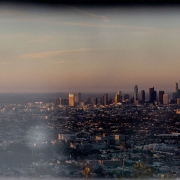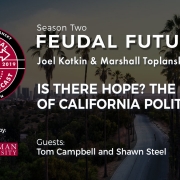Tarnishing the Golden State
No state advertises its egalitarian bona fides more than California. Governor Gavin Newsom brags that his state is “the envy of the world,” a place that is “not going to abandon our poor people.” In his inauguration speech, he claimed that “unlike the Washington plutocracy, California isn’t satisfied serving a powerful few on one side of the velvet rope. The California Dream is for all.” Yet even as Newsom and his progressive allies have backed Black Lives Matter and enacted a racialized “ethnic studies” curriculum in public schools, reality tells a less positive story. The Golden State’s racial minorities are far from thriving. Increasingly, they’re seeking fortunes elsewhere—often to redder, less “enlightened” states.
The minorities leaving California are not running away from beautiful weather or scenery but toward an opportunity horizon that no longer seems achievable in the Golden State. In a new report for Chapman University, my coauthors and I found that African-American and Latino Californians’ real earnings ranked between 48th and 50th among the states. Blacks in California earn roughly the same, or slightly less, than do their counterparts in Mississippi. The state has the nation’s worst cost-adjusted poverty rate and the third-highest Gini Inequality index (behind New York and Louisiana). According to the United Way of California, over 30 percent of California residents lack sufficient income to cover basic living costs even after accounting for public-assistance programs; this includes half of Latino and 40 percent of black residents.
It was different once. Ever since the nineteenth-century Gold Rush, people from around the world rushed to California to seek their fortunes, giving the state a diverse population of whites, Asians, Latinos, and blacks. Deeply afraid of an “Asian invasion” into what newcomers called Gold Mountain, incumbent Californians limited the rights of Chinese, Japanese, and other migrants from the East and backed racially oriented bans originating from Washington, D.C. that lifted only in the early 1950s. The Asian population has risen since. Until 1990, Asians were not systematically enumerated in the decennial census but were instead combined with Pacific Islanders; this larger grouping increased from 2.0 percent to 9.6 percent of the state’s population, according to Census Bureau research. The state’s Asian population increased from 10.9 percent in 2000 to 15.1 percent in 2020.
Immigrants also entered from Mexico, at first to escape the chaos of that country’s brutal 1910–1920 revolution. Controls on Mexican migration tended to follow economic conditions, but a liberalization of immigration laws in 1965, and a mass amnesty in 1986, assured that Latinos would be the Golden State’s largest group. Census Bureau research indicates that California’s Hispanic population rose from 6.0 percent in 1940 to 13.7 percent in 1970 and 32.4 percent in 2000. A figure of 37.6 percent was reached in 2010, rising to 39.4 percent in 2020.
Finally, African-Americans started coming to the state in the 1920s and 1930s, with their numbers increasing during World War II. Lured by good jobs in the state’s burgeoning aircraft, automobile, and construction economies, blacks may have faced some discrimination, but far less than they did elsewhere. In L.A., wrote Ralph Bunche, blacks were “eating high up” off the hog. As late as 1940, less than 2 percent of the population was black—a number that more than doubled by 1950 and reached a peak of 7.7 percent in 1980. Since 2000, however, California’s black population has dropped from 6.7 percent to 5.4 percent.
Today, the California opportunity structure is no longer so promising. Once seen as a mecca of sorts for blacks, L.A. now ranks toward the bottom of the Urban Reform Institute’s Upward Mobility Index, which measures such factors as income, housing affordability, unemployment, educational attainment, and homeownership. San Francisco does poorly by the same metrics. The best American cities for upward mobility today are not Los Angeles or San Francisco but Atlanta; Phoenix; Virginia Beach and Richmond, Virginia; and Lancaster, Pennsylvania.
Read the rest of this piece at City Journal.
Joel Kotkin is the author of The Coming of Neo-Feudalism: A Warning to the Global Middle Class. He is the Roger Hobbs Presidential Fellow in Urban Futures at Chapman University and Executive Director for Urban Reform Institute. Learn more at joelkotkin.com and follow him on Twitter @joelkotkin.
Photo: City Journal.




 Gage Skidmore, used under CC 2.0 License
Gage Skidmore, used under CC 2.0 License



 NREL, used under CC 2.0 License
NREL, used under CC 2.0 License